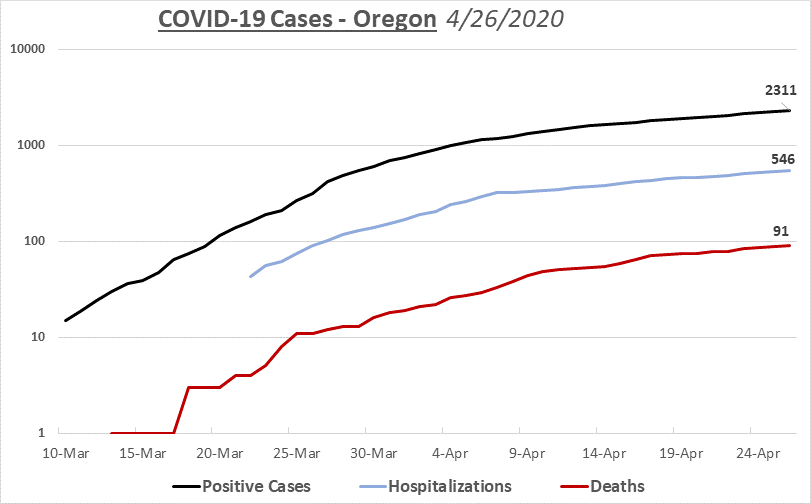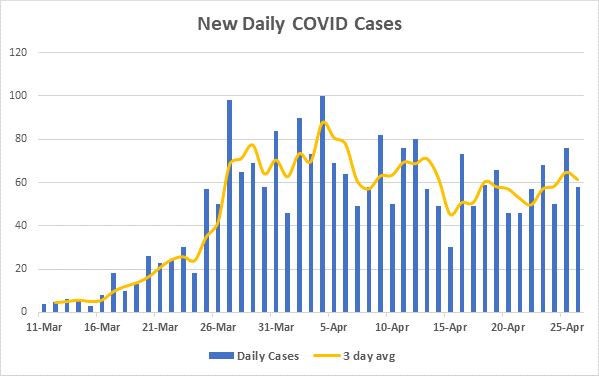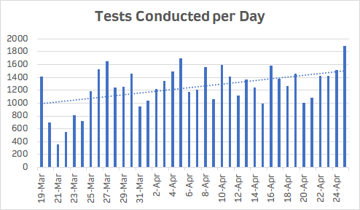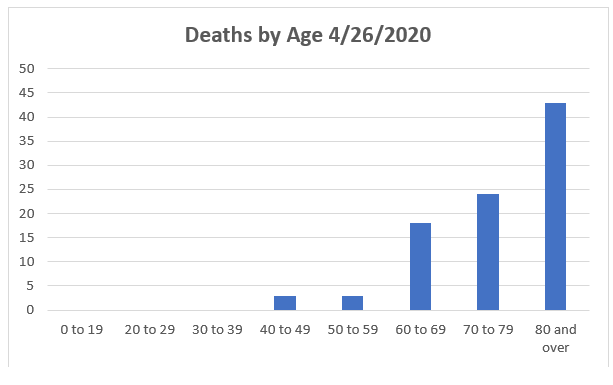|
April 26, 2020
Dear Neighbors and Friends:
I hope that you and your loved ones are doing well, staying healthy, and looking out for your neighbors and friends.
Today’s newsletter is mainly an end-of-week collection of graphs, charts, and numbers, just to give you a sense of where we are in the trajectory of the disease. There’s also a new message from the Employment Department, which—I don’t have to tell you—has really been struggling to handle the onslaught of people seeking benefits for the first time.
While hundreds of millions of dollars in unemployment benefits are already going out to Oregonians, many are still waiting to receive their first check, and many will have to wait a couple of weeks still. This is so frustrating, including for those who are working hard to get through this onslaught of new claims. It’s crucial that workers whose workplaces have had to close as either a direct or an indirect result of the coronavirus crisis receive the support they need to make ends meet until it’s safe for them to return to work. We can all agree on that.
Speaking of safety, I am starting to hear from constituents who are concerned that they will be called back to work in the first phases of the Reopening plan, and they feel it will be impossible for them to stay safe because of the kind of work that they do. This is an especially acute problem for workers who are particularly vulnerable to the effects of the virus or who live with someone who is. It’s completely understandable. I’ve heard from hairdressers, dental hygienists, and others whose work brings them into very close contact with clients/patients, who are very concerned.
We should be hearing details around the requirements for the reopening of non-emergency medical (scheduled for May 1) by the middle of this week. I hope that the various medical licensing boards will be able to weigh in and make their members feel confident that it’s safe for them to return to work. The same will be true for the Board of Cosmetology, Massage, and other professional boards overseeing practices in the “personal care” industries.
I’ll be arguing for the ability of workers in these professions that bring them into close contact with the public to refuse a return to work offer if they or their household members are in the “vulnerable” category. It would be terrible to see instances of acute COVID-19 illness among groups of people who we know are vulnerable and that could have been avoided. It seems to me that until we’re really confident that it’s safe for them to return to this kind of work, i.e., until we’re at least in Phase Two or Phase Three of the reopening, it makes sense to keep these at-risk individuals away from work for the time being. We should be able to craft the reopening plan in a way that allows individuals who are at particular risk to be able to stay home and continue to receive unemployment benefits until it’s safe for them to return. I assume that most employers would agree.
I’d love to get your thoughts on this.
TODAY’S CORONAVIRUS AND CORONAVIRUS RESPONSE UPDATE

***Please notice that I’m now using an exponential scale for the Y axis on this graph. Doing it this way allows for a more realistic sense of the upward curves of these three data points (positive cases, hospitalizations, and deaths).
-
Positive Cases: OHA has reported that 58 additional Oregonians tested positive for COVID-19 yesterday, putting the total at 2,311.
-
Total Tests: The problem with this metric has been completed. The total number of tests in Oregon now stands at 48,964. That’s an increase of 1,587 tests.
-
Ratio: The percentage of positive results still remains just under 5% (4.72% to be exact!). That’s much lower than the national average (coming down, but still at 17.6%).
-
Deaths: I’m afraid I have to report that 4 additional Oregonians have died from the disease, so the total number of deaths in Oregon is now 91.
-
Hospitalized: The number of Oregonians who have been hospitalized with symptoms, and who have also tested positive for the disease, is now at 536. This is an increase of 16 from yesterday.
-
Other Hospital Information:
- Available ICU Beds: 280 (an increase of 3 from yesterday)
- Other Available Beds: 2,014 (a decrease of 57 from yesterday)
- Patients Currently w COVID-19 Symptoms (who may or may not have received a positive test result yet): 249 (a decrease of 12 from yesterday). Of those, 128 have already received a positive test back.
- ICU Patients w COVID-19 Symptoms (who may or may not have received a positive test result yet): 71 (11 more than yesterday)
- COVID-19 Patients Currently on Ventilators: 31 (2 more than yesterday).
- Available Ventilators: 795 (6 more than yesterday)
-
Today’s National Numbers:
-
PPE:
- The Emergency Coordination Center received 288,800 N95 respirator masks and 40,000 pairs of gloves in the last 24 hours.
Additional Daily Graphs:




*** Remember that the hospitalization numbers being used here are those currently in the hospital with symptoms, but who may or may not have received a positive test result yet.



More Numbers
I’ve put together the following chart, showing the overall weekly sums of the Positive Tests (w All Tests added for perspective), Hospitalizations, and Deaths over the past four weeks. You’ll see that the weekly rates of increase in Oregon continue to be high, but they are going down.
|
|
Positive Tests
|
All Tests
|
Hospitalizations
|
Deaths
|
|
April 5
|
1,068
|
20,624
|
258
|
27
|
|
April 12
|
1,527 (+43%)
|
29,758 (+44%)
|
359 (+39%)
|
52 (+93%)
|
|
April 19
|
1,910 (+25%)
|
39,038 (+31%)
|
456 (+27%)
|
74 (+43%)
|
|
April 26
|
2,311 (+21%)
|
48,964 (+25%)
|
546 (+20%)
|
91 (23%)
|
Another Tracking Report from Our Friend in Eugene
I just received another update from Brian Wanty of Eugene on the trajectory of the disease in Oregon. As you’ll see from his tracking report, he is concerned that Oregon may be considering reopening too soon. His numbers suggest that transmission in Oregon is still on the rise. He shares the concern that we heard from our official modelers, The Institute for Disease Modeling, that if it’s not accompanied by a serious testing/tracing/tracking/isolation regime, we will see our number of new cases rebound. It’s fair to say that we all want to see this kind of serious regime in place, but it’s not yet clear how quickly it can reach the necessary scale.
Thank you again, Brian.
A New Message from the Unemployment Department
Late Saturday night legislators received an update from the Employment Department’s Deputy Director. She has been our point of contact for issues that have arisen for constituents struggling to receive their benefits. Although the benefits are starting to flow for many, there are many who are still waiting and waiting. The normal waiting time after filing to receive benefits is three weeks. As Jeannine mentions in the update, we now have people who have been waiting four or five, especially (though not exclusively) those with somewhat unusual or complicated cases and certainly those in the category of workers not previously eligible for UI.
Whether you are currently receiving benefits, waiting to receive benefits, or still waiting to be able to file, I’d suggest you read the update in its entirety. There’s a lot of information in it.
For the general reader, here are a few of the highlights:
- The department has processed more than 230,000 new claims in the last month.
- People are submitting weekly claims—AS THEY SHOULD—but until the initial claim has been approved, the subsequent claims cannot be processed.
- Claims are being backdated as needed. Applicants will be eligible for retroactive pay once their claim is sorted out and approved.
- This includes the additional federal weekly benefit of $600.
- As recommended, huge numbers of people have been taken advantage of the direct email address. That’s good. The downside is that claims processors are not able to keep up and meet the promise of responding in under a week. They hope to catch up this week.
- Work Share benefits are also being processed slowly. (Work Share is the program that allows workers who have not been laid off, but whose hours are reduced to receive benefits to make up for those lost hours.)
- Some employers are concerned that their low-wage workers may be receiving more in benefits than they were when they were working and won’t want to return.
- Some workers are worried about being called back to work earlier than they feel safe to return and risk exposure.
- Explains several confusing messages that applicants may have received while trying to file.
The numbers of new applicants will soar at the end of this week, as workers now eligible under the new Pandemic Unemployment Assistance program are finally able to apply. We’re told that processes will be in place by the end of the month. I’ll let you know more about that when we hear more.
Want to See Past Newsletters?
If there was COVID-related information in a past newsletter that you want to go back to, but find you’ve deleted it, you can always go to my legislative website (www.senatordembrow.com), click on “News and Information,” and you’ll find them all there.
AND FINALLY,
Here again are some resources that you will find useful:
If the above links are not providing you with answers to your questions or directing you to the help that you need, please consider me and my office to be a resource. We’ll do our best to assist you or steer you in the right direction.
Best,
 Senator Michael Dembrow
District 23
email: Sen.MichaelDembrow@oregonlegislature.gov
web: www.senatordembrow.com
phone: 503-986-1723
mail: 900 Court St NE, S-407, Salem, OR, 97301
|